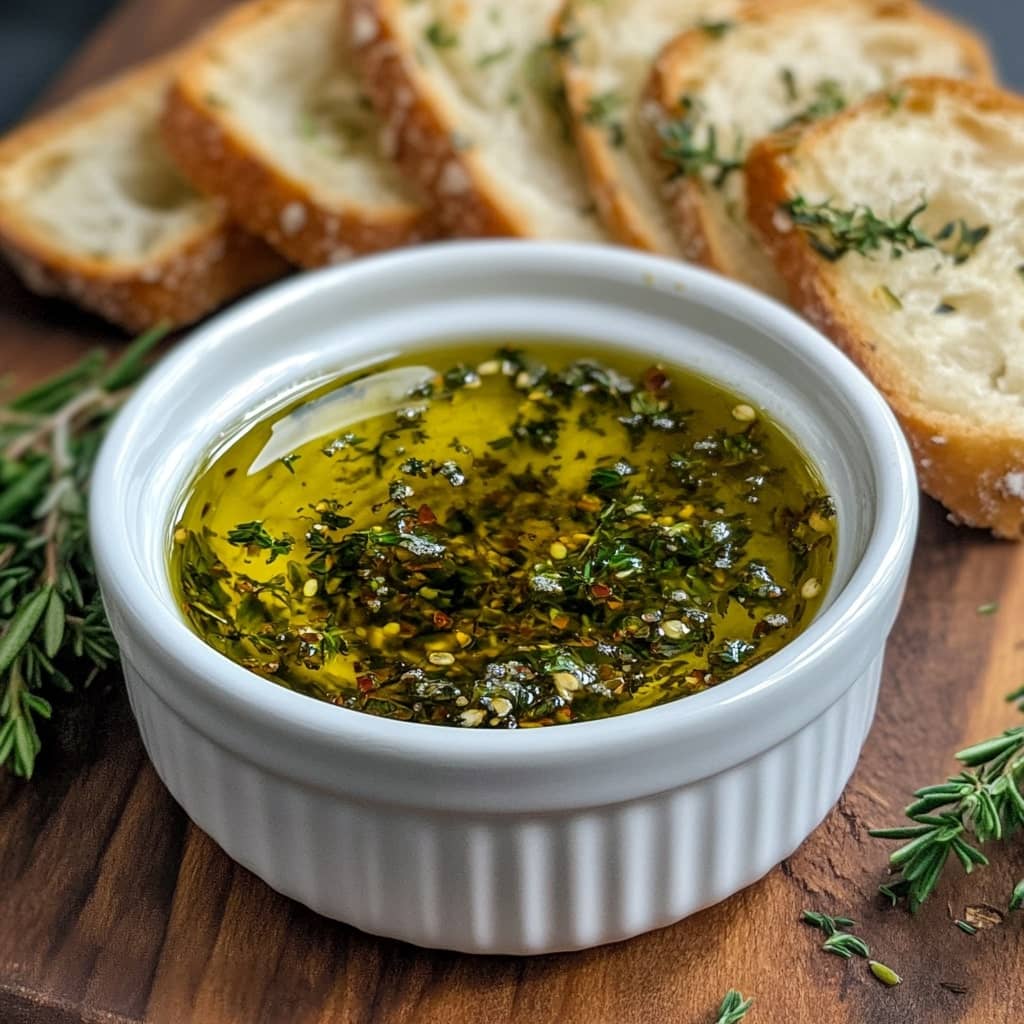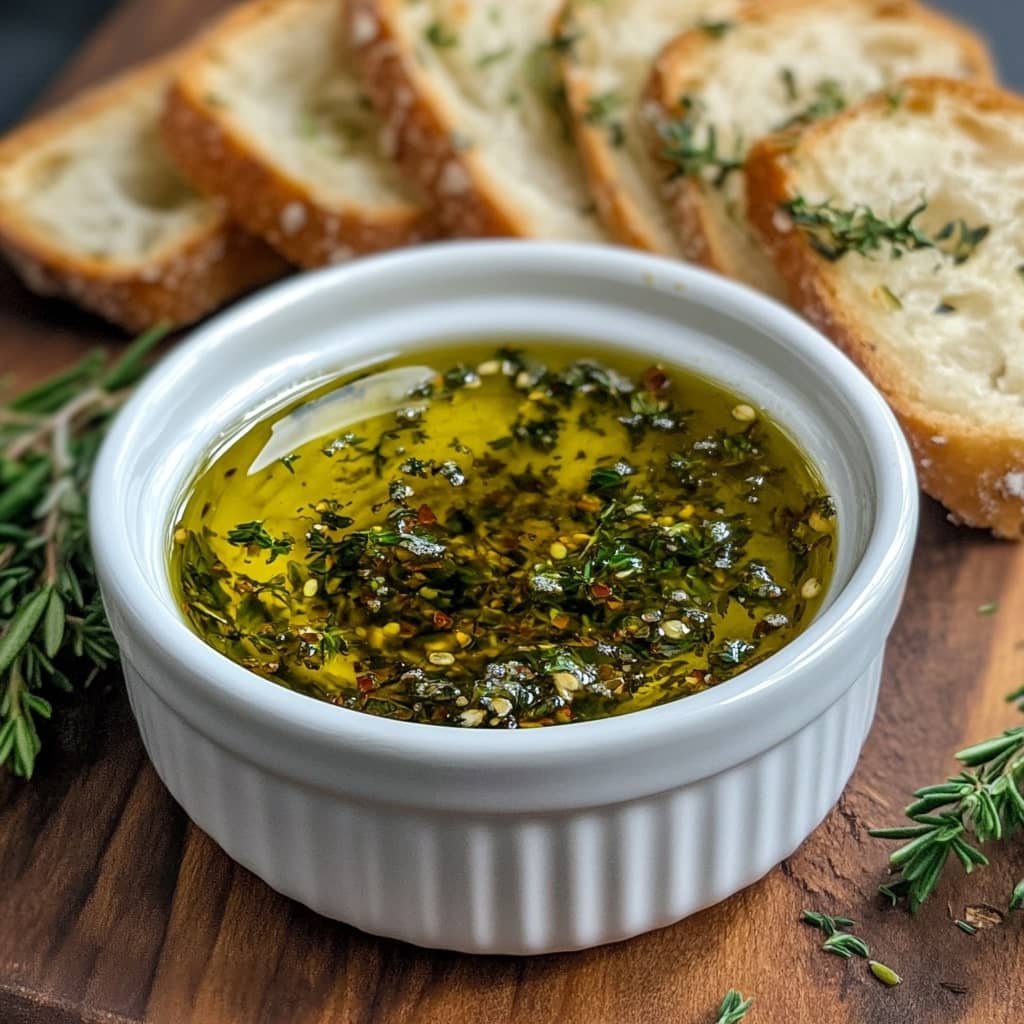Olive oil bread dip, also known as bread dipping oil, is a savory, aromatic, and effortlessly elegant appetizer that instantly elevates any meal or gathering. Often served alongside warm, crusty bread, this dip blends rich extra virgin olive oil with fragrant herbs, spices, garlic, and sometimes balsamic vinegar or grated cheese to create a medley of bold Mediterranean flavors. With just a few quality ingredients and no cooking required, this versatile dip can be whipped up in minutes, making it a go-to choice for entertaining, snacking, or starting a delicious Italian-inspired dinner. Whether you’re hosting guests or enjoying a quiet night in, a bowl of flavorful olive oil paired with artisan bread creates a restaurant-worthy experience that feels both rustic and refined.
The history of olive oil bread dip is deeply rooted in Mediterranean and Middle Eastern culinary traditions, where olive oil has been a staple for thousands of years. Ancient Greeks and Romans not only used olive oil for cooking and cosmetics but also consumed it with bread as a simple and nourishing meal. In Italy, the concept of dipping bread into seasoned olive oil dates back centuries, especially in Tuscany, where it’s common to enjoy freshly pressed oil, or olio nuovo, with toasted bread and a sprinkle of sea salt—a tradition known as fettunta. Though traditionally olive oil was more often poured over dishes rather than used as a dip, the modern version of bread dipping oil—often mixed with herbs, spices, garlic, and vinegar—gained popularity in the late 20th century, particularly in North American restaurants offering Italian-style appetizers. Today, it’s beloved around the world for its bold flavor, simplicity, and adaptability.
Ingredients Breakdown
The essential ingredient is high-quality extra virgin olive oil, which forms the base of the dip and provides a smooth, fruity, and sometimes peppery flavor. To this, minced fresh garlic or garlic powder adds pungency, while dried or fresh herbs such as basil, oregano, thyme, parsley, and rosemary introduce depth and complexity. Crushed red pepper flakes or black pepper offer a subtle heat, and sea salt or kosher salt brings out all the other flavors. Optional but popular additions include a splash of aged balsamic vinegar for acidity and sweetness, grated Parmesan or Pecorino Romano for umami richness, and even lemon zest for a hint of brightness. Some versions incorporate sun-dried tomatoes, capers, or olives for a briny twist. The beauty of this dip lies in the balance between quality ingredients and bold, complementary flavors.
Step-by-Step Recipe:
- Choose a shallow serving dish or small bowl for serving.
- Pour in ½ cup of high-quality extra virgin olive oil.
- Add 1–2 minced garlic cloves (or ½ teaspoon garlic powder if preferred for a milder flavor).
- Stir in 1 teaspoon dried Italian herb blend, or use a mix of ¼ teaspoon each of dried basil, oregano, parsley, and thyme.
- Add ¼ teaspoon crushed red pepper flakes (adjust to taste) and a generous pinch of sea salt and freshly cracked black pepper.
- Optional: Add 1 tablespoon aged balsamic vinegar, 2 tablespoons finely grated Parmesan cheese, and/or a pinch of lemon zest.
- Mix all ingredients gently to combine, then let the dip sit for 10–15 minutes to allow the flavors to meld.
- Serve with warm crusty bread such as ciabatta, sourdough, or baguette slices. You can toast the bread lightly for added texture.
Tips for the Perfect Dip
Always use the best-quality extra virgin olive oil you can find—it’s the foundation of the flavor. Fresh garlic offers a more intense taste than powdered, but garlic powder is a good choice for a smoother consistency and longer shelf life. Letting the mixture sit before serving helps infuse the oil with the flavors of the herbs and spices. Don’t skip the salt; even a small amount can elevate the entire dish. For variety, serve in a small platter with ingredients layered rather than mixed—guests can swirl their bread through the layers for different flavor experiences. Toasting the bread gives it structure and a slightly smoky depth that pairs beautifully with the oil.
Variations and Customizations
You can easily customize the dip to suit your taste or theme. Add a Mediterranean twist by mixing in finely chopped sun-dried tomatoes, kalamata olives, or capers. For a spicy version, increase the red pepper flakes or add a touch of chili oil. Switch out the Italian herbs for Middle Eastern za’atar or North African dukkah for international flair. Use truffle oil or garlic-infused olive oil for an upscale touch. Add a drizzle of honey or a spoonful of fig preserves for a sweet-and-savory profile. Grated hard cheeses like Asiago, Manchego, or even nutritional yeast (for a vegan option) can bring in extra richness and depth.
Health Considerations and Nutritional Value:
Olive oil bread dip can be a healthful addition to your diet when consumed in moderation. Extra virgin olive oil is a good source of heart-healthy monounsaturated fats and antioxidants, including vitamin E and polyphenols. Garlic offers antimicrobial and anti-inflammatory properties, and herbs provide a variety of micronutrients and flavor without added calories. However, it is a calorie-dense food, with about 120 calories per tablespoon of olive oil. To keep it balanced, enjoy with whole grain or multigrain bread, or use portion control when dipping. For lower sodium versions, reduce added salt and opt for unsalted herb blends. Those watching their fat intake can substitute part of the olive oil with a splash of lemon juice or balsamic vinegar for a lighter flavor profile.
FAQ
Can I make the dip ahead of time? Yes, you can mix the dry ingredients into the olive oil and let it infuse for several hours or overnight. For the freshest taste, add garlic shortly before serving.
Do I have to use balsamic vinegar? No, it’s optional and depends on your taste preference. Some prefer a purely herbal and garlicky oil without the acidity.
Can I store leftovers? Yes, store the dip in an airtight container in the fridge for up to 3–4 days. Let it come to room temperature before serving, as olive oil may solidify when chilled.
Is it okay to use infused olive oil? Absolutely! Garlic, chili, or lemon-infused oils can add an extra layer of flavor.
What kind of bread works best? Crusty breads like baguette, ciabatta, sourdough, or even focaccia are ideal for dipping—they hold their shape and absorb the oil well.
Can I make it vegan or dairy-free? The base dip is naturally vegan and dairy-free. Just skip any cheese additions or use a plant-based alternative if desired.

Olive Oil Bread Dip | Bread dipping oil
Ingredients
Method
- Pour the olive oil into a small serving bowl or plate.
- Add the Italian seasoning, garlic, basil, red pepper flakes, black pepper, fresh basil, Parmesan cheese, and salt.
- Just before serving, drizzle the balsamic vinegar over the mixture.
- Serve with warm, crusty bread and enjoy!
Notes
Shred your own Parmesan cheese instead of using pre-shredded, which is coated with additives.
It’s crucial to use the highest quality extra virgin olive oil (EVOO) for this recipe.
Feel free to adjust the spices and herbs to your taste—this recipe is very versatile, and you can’t go wrong.
Chop the basil as finely as possible for the best texture and flavor.
You can also substitute freshly squeezed lemon juice if desired.
For quick FAQs, be sure to check out the blog post above the recipe card.
